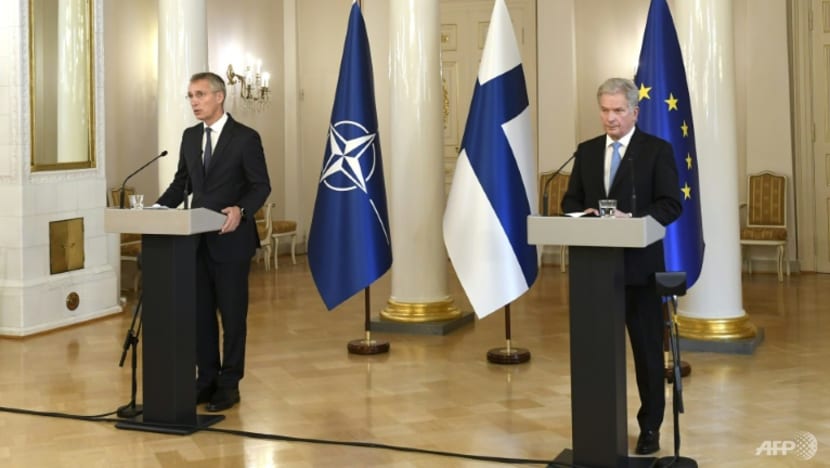Commentary: Putin has successfully redrawn Europe's map, just not in the way he wanted
A new European security order will emerge from the ruins of the war in Ukraine, taking us back to the Cold War, says an international security professor.

NATO Secretary General Jens Stoltenberg (L) met Finland's President Sauli Niinisto last year. (Photo: Lehtikuva/AFP/File/Vesa Moilanen)
BIRMINGHAM, England: With Finland’s leaders announcing that they want the country to join the North Atlantic Treaty Organization (NATO), and all the signs pointing to Sweden doing the same, it is becoming clearer than ever that Russian President Vladimir Putin’s attempt to fundamentally restructure the European security order has worked.
But it hasn’t worked the way that the Russian president envisaged when it comes to NATO-Russia or Russia-United States relations.
Neutrality, as a status in international law and a foreign policy stance, is no longer seen as a viable way for smaller countries to navigate the danger zones of great power rivalries. A longstanding constitutional imperative to be neutral has not protected Moldova from Russian threats that it might be next on the list of territories that the Kremlin wants to conquer in its attempts to restore a Soviet-style Russian sphere of influence.
Russia’s aggression against Ukraine – and the way in which Putin has justified it again in his Victory Day speech on Red Square – offers no confidence that fundamental principles of the established European security order matter to Moscow.
This has been the case at least since the Russia-Georgia war in 2008 and should have been patently obvious with the Russian annexation of Crimea and occupation of Donbas in 2014.
NEUTRALITY ONLY IN THEORY
But the brutality of the war in Ukraine, its proximity to European Union and NATO’s borders, and the danger that Russia’s expansionism will not stop there make it critical for the survival of nearby states to rethink their security arrangements.
That is what Sweden and Finland are doing, and the answer that they have come up with is to join NATO.
Neutrality has worked, especially for Finland, through both the Cold War and post-Cold War periods. Based on the 1947 allied peace treaty with Finland and the 1948 Finno-Soviet Agreement of Friendship, Cooperation, and Mutual Assistance, Finnish neutrality meant that the country was not to “conclude or join any coalition directed against” the Soviet Union in exchange for an allied guarantee of the country’s sovereignty and territorial integrity.
Finland’s application for NATO membership might therefore be seen as a breach of its treaty obligation. The 1969 Vienna Convention on the Law of Treaties is very specific about the fact that “every treaty in force is binding upon the parties to it and must be performed by them in good faith”. This is often referred to with the notion of pacta sunt servanda (agreements must be kept).
However, the convention also establishes that a “fundamental change of circumstances” may be invoked as a reason to withdraw from a treaty if “the existence of those circumstances constituted an essential basis of the consent of the parties to be bound by the treaty”. Clearly, Russia’s aggression against Ukraine constitutes such a fundamental change of circumstances.
NEUTRAL COUNTRIES ARE BECOMING DIVIDED
The consequences of Russia’s challenge to the established European security order, however, go beyond likely Finnish and Swedish NATO membership. Ukraine, together with Georgia and Moldova, has already been pushed into submitting a bid for EU membership.
These bids might take years to come to fruition. But they signify a trend not only of further alignment but also of deeper division within Europe. As the antagonism between the East and the West grows, it reduces the space for states to exist in between rival powers.
This, in turn, is also likely to have implications for other neutral states. Switzerland has increasingly aligned with the EU on Russian sanctions. Austria and Ireland have long participated in the EU’s common security and defence policy. The strong and united Western response to Russia’s aggression against Ukraine is only going to further consolidate this trend.
On the other hand, the pressure to take sides on currently non-aligned states elsewhere in the post-Soviet space, including Azerbaijan, Turkmenistan and Uzbekistan, will increase.
They will be pressured to join the Russian-led Collective Security Treaty Organization (of which Azerbaijan and Uzbekistan are former members) or intensify their cooperation with the China-led Shanghai Cooperation Organisation (in which Russia is already a key member, alongside Uzbekistan, with Azerbaijan a “dialogue partner”).
UKRAINE IS UNLIKELY TO ACCEPT NEUTRALITY AS A PEACE TERM
The deepening division within Europe and the end of neutrality as a viable approach to national security are not only driven by Russia’s unjustifiable invasion of Ukraine. They also have significant ramifications for how it might end. The idea of Ukrainian neutrality as a “solution” that would placate Putin enough to make a deal is now even less viable.
Why would Ukraine be persuaded by Russian assurances to respect its neutrality if states like Finland and Sweden, which are not under attack, no longer feel that neutrality guarantees their security?
With neutrality off the table, the bargaining space between Russia and Ukraine becomes even smaller and the probability of both sides seeking victory on the battlefield increases. This is despite the enormous cost that a military victory would entail and the fact that a protracted and inconclusive stalemate in the form of a long war of attrition is a more likely outcome.
Eventually, a new European security order will emerge from the ruins of the war in Ukraine. It will be one that will take us back to the Cold War, albeit with the iron curtain drawn differently. There will be little, if any, space left for countries to navigate their security concerns between the rival blocs.
These alliances are likely to consolidate and entrench more deeply than ever over the past three decades since what was assumed to be the end of the Cold War.
Such a new order will provide more security for those countries aligned with NATO and the EU. The way there, however, will be long and paved with inevitable setbacks. How quickly we will get there will be determined in Ukraine.
Stefan Wolff is a Professor of International Security at the University of Birmingham. This commentary first appeared in The Conversation.

















